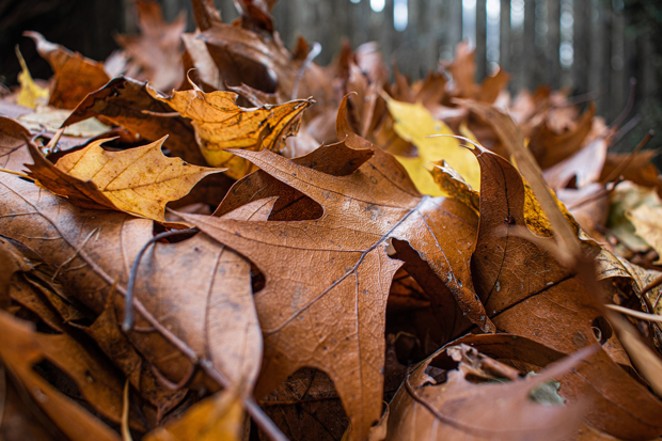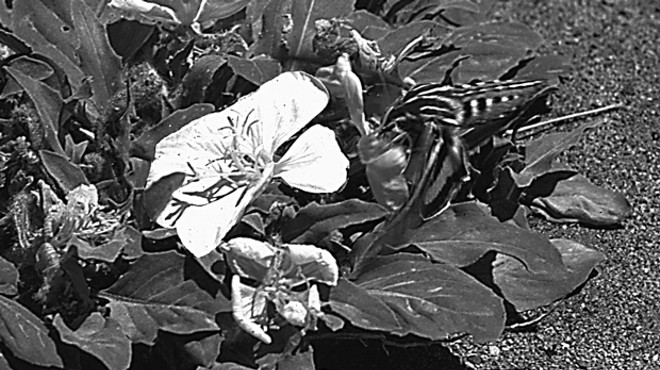Every autumn, in the few months between our short growing season and our long winter, Central Oregonians must contend with another challenge: leaves. So many leaves.
Cristy Harvey knows the challenge well. Her small 1920s home sits on an average-sized west-side lot with an outsized backyard. Right now, that yard is layered in leaves and needles that have fallen — and are falling — from six fruit trees, four ponderosa pines, assorted other small trees and untold shrubs, including roses, red-osier dogwoods and enough currants and bramble fruits to feed friends for months.
And that's only a partial list of the plants on her own property. Harvey also must contend with foliage that falls from her neighbors' trees, including one particularly prodigious leaf maker — a large quaking aspen that she drily notes "does not respect property lines."
Dealing with leaves every autumn, Harvey admits, "I sometimes feel a sense of Sisyphean futility."
Many in Bend can relate. We may not have as many deciduous trees as Western Oregon, but those we do have shed more than enough foliage to form berms and fill wheelbarrows. The annual question is what to do about all those leaves: blow them, mow them, bin them, bag them or leave them be?
Leave the leaves
Experts say the primary answer is the latter — leave the leaves where they fall. Oregon State University Extension notes that "leaves are a readily available organic matter source" that can be left on top of vegetable gardens and under shrubs and trees to "smother winter annual weeds, decrease runoff, and increase soil water retention for the following summer."In other words, leaves provide many of the same benefits as bark mulch, only without the cost and slivers. Rick Martinson, co-owner of WinterCreek Restoration and Nursery, adds that bark mulch and wood chips can stress soil because they're difficult to break down.
Conversely, he says, "Leaves feed microbial populations in the soil that benefit plants. If you rake away all that organic material, you're going to stress out your plants. Then you have to buy fertilizer to try to replace what the leaves were doing in the first place."
Harvey has another reason for leaving the leaves on her property: It's easy. She's a big believer in what she calls "lazy gardening," noting, "Mulch makes it sound like there's some effort involved, when in reality I just let most leaves overwinter where they fall. By spring the leaves have composted themselves in place, so I don't have to do anything with them."
For aesthetics and to clear walkways, storm drains and lawns, it's often necessary to move some leaves. Martinson suggests piling those leaves under plants or in corners of the yard. If you have a compost pile, you can place them there, which is what Harvey does with the many, many leaves volunteered by her neighbor's aspen tree.
"I actually really like having a couple wheelbarrow loads of aspen leaves that I can put on my compost pile because worms love them," she says. "The leaves break down nicely, and they're free."
Balancing human and wildlife needs
One source of leaves in Harvey's yard is the 15-foot-long stretch of raspberries along her garage. "Midsummer, from dawn to dusk it's a buzzing, vibrating area, full of bees," she says. "But one day last summer, I noticed there were so few bees I could count them. That was kind of an 'Oh, shit' moment."Recent studies don't use that exact language, but they've identified the same problem: Insects are disappearing. It's difficult to count populations of a million different species, but many appear to be declining fast. That's dangerous because insects pollinate much of the food we eat and are at the base of the food chain. As they go, so go birds and countless other species.
That connects back to the leaves in our yards because leaves provide food and shelter for bees, butterflies, moths and other small animals. Mowing and shredding leaves eliminates their overwintering habitat and kills those that are attached to or mixed in with the leaves as eggs, larvae or adults.
Harvey admits that she doesn't love interacting with all insects—earwigs, for example. "A, they're gross," she says. After a long pause, it becomes clear that there is no "B." However, she also recognizes that, as Martinson says, "there's a whole ecosystem in leaf litter, including a lot of critters that are needed to break down the leaves."
So, while she doesn't like looking at earwigs or having her kale leaves nibbled, Harvey contends that she'd, "Much rather work with insects to find a really comfortable balance where I can grow what I like and wildlife can have a good time too."
In her 16 years in Bend, Harvey has yet to run out of uses for all her leaves. She doesn't even need a yard debris bin because she puts all of her leaves—and those gifted from her neighbors—to work in her yard, either feeding the soil, feeding her compost or feeding and housing insects and other wildlife.
Rick Martinson, a Central Oregon Master Gardener with a Ph.D. in horticulture, offers these tips for managing leaves in fall.
Most leaves: Leave most leaves where they fall as free mulch for trees, shrubs and vegetable gardens. To avoid moisture and disease transfer, make sure there are a few leaf-free inches around stems and trunks.
Walkways: Rake or sweep leaves off walkways so they won't get slick in winter. Stack the leaves in piles that are fun for kids and provide overwintering habitat for pollinators and other wildlife.
Lawns: A thick mat of leaves will smother lawns, so rake or sweep leaves off. Avoid mowing or shredding, which will kill butterflies and other insects in and on the leaves.
Compost bin: If you have an outdoor bin or pile, add leaves as carbon-rich brown matter to feed soil-dwelling organisms.
Pine needles: For most urbanites, Martinson suggests removing all but about an inch-high layer of needles under pine trees. The idea is to emulate the frequent ground fires that burn needles in healthy eastside pine forests. Excess needles can be put in bins or composted over many years.























